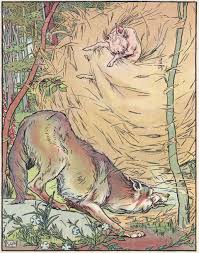Australian folklorist, historian and writer (1854–1916)
For other people named Joseph Jacobs, see Joseph Jacobs (disambiguation).
Joseph JacobsPhotograph of Jacobs taken in 1900Born(1854-08-29)29 August 1854Sydney, Colony of New South WalesDied30 January 1916(1916-01-30) (aged 61)Yonkers, New York, United StatesOccupation
Folklorist
critic
historian
NationalityBritish subjectAlma materUniversity of SydneySt John's College, CambridgeUniversity of BerlinSubjectIndo-European fairy tales; Jewish history
Joseph Jacobs (29 August 1854 – 30 January 1916) was a New South Welsh-born British-Jewish folklorist, translator, literary critic, social scientist, historian and writer of English literature who became a notable collector and publisher of English folklore.
Jacobs was born in Sydney to a Jewish family.
His work went on to popularise some of the world's best known versions of English fairy tales including "Jack and the Beanstalk", "Goldilocks and the Three Bears", "The Three Little Pigs", "Jack the Giant Killer" and "The History of Tom Thumb". He published his English fairy tale collections English Fairy Tales in 1890 and More English Fairy Tales in 1893[a]. He published European, Jewish, Celtic, and Indian fairy tales, which made him one of the most popular English-language fairy tale writers. Jacobs was also an editor for journals and books on the subject of folklore which included editing the Fables of Bidpai and the Fables of Aesop, as well as articles on the migration of Jewish folklore. He also edited editions of The Thousand and One Nights. He went on to join The Folklore Society in England and became an editor of the society journal Folklore.[1] Joseph Jacobs also contributed to The Jewish Encyclopedia.
During his lifetime, Jacobs came to be regarded as one of the foremost experts on English folklore.
Biography[edit]
Early life[edit]
Jacobs was born in Sydney, New South Wales, on 29 August 1854.[2]
He was the sixth surviving son of John Jacobs, a publican who had emigrated from London in around 1837, and his wife Sarah, née Myers.[3] Jacobs was educated at Sydney Grammar School and at the University of Sydney, to which he won a scholarship for classics, mathematics and chemistry. He did not complete his studies in Sydney, but left for Britain at the age of 18.[4]
Jacobs attained his BA from St John's College, Cambridge.
He then studied at St John's College, Cambridge, where he gained a BA in 1876.[5] At university he demonstrated a particular interest in mathematics, philosophy, literature, history, and anthropology.[5] While he was in Britain Jacobs became aware of widespread anti-Semitism; to counter this he wrote an essay, "Mordecai", which was published in Macmillan's Magazine in June 1877[6] Later in 1877 he moved to Berlin to study Jewish literature and bibliography under Moritz Steinschneider, and Jewish philosophy and ethnology under Moritz Lazarus.[7]
Jacobs then returned to Britain and studied anthropology under Francis Galton.[7] At this point he began to further develop his interest in folklore.[7] From 1878 to 1884 he served as secretary of the Society of Hebrew Literature.[7] He was concerned by the anti-Semitic pogroms in the Russian Empire and in January 1882 wrote letters on the subject to The Times of London. This helped to raise public attention to the issue, resulting in the formation of the Mansion House Fund and Committee, of which he was secretary from 1882 to 1900.[7] He was the honorary secretary of the literature and art committee of the Anglo-Jewish Historical Exhibition held in the Royal Albert Hall in London in 1887, and with Lucien Wolf he compiled the exhibition catalogue.[7]
In 1888 Jacobs visited Spain to examine old Jewish manuscripts there. The Royal Academy of History at Madrid elected him a corresponding member.[8]
In 1891 he returned to the theme of Russian anti-Semitism in a short book, The Persecution of the Jews in Russia, which was published first in London and then in the United States by the Jewish Publication Society of America.[8]
In 1896 Jacobs began publication of the annual Jewish Year Book, continuing the series until 1899, after which it was continued by others.[8] He was also President of the Jewish Historical Society.[9]
Later life[edit]
In 1896 Jacobs visited the United States to deliver lectures on "The Philosophy of Jewish History" at Gratz College in Philadelphia, as well as to groups of the Council of Jewish Women in New York, Philadelphia and Chicago.[10]
In 1900 he was invited to serve as revising editor for the Jewish Encyclopedia, which included entries from 600 contributors.[11] He moved to the United States to take on this task.[11] He also involved himself in the American Jewish Historical Society,[11] became a working member of the Jewish Publication Society's publication committee.[12] and taught at the Jewish Theological Seminary of America.[9]
Jacobs married Georgina Horne, and fathered two sons and a daughter. In 1900, when he became revising editor of the Jewish Encyclopedia, based in New York, he settled permanently in the United States.[citation needed]
He died on 30 January 1916 at his home in Yonkers, New York, aged 62.[5][3]
Career[edit]
1919 edition of The Book of Wonder Voyages (1896)
Jacobs was a student of anthropology at the Statistical Laboratory at University College London in the 1880s under Francis Galton. His Studies in Jewish Statistics: Social, Vital and Anthropometric (1891) made his reputation as the first proponent of what was then called "Jewish race science".[13]
In 1908 he was appointed a member of the board of seven editors that made a new English translation of the Bible for the Jewish Publication Society of America.[14]
In 1913 he resigned his positions at the seminary to become editor of the American Hebrew.
In 1920 Book I of his Jewish Contributions to Civilization, which was practically finished at the time of his death, was published in Philadelphia.
In addition to the books already mentioned, Jacobs edited The Fables of Aesop as First Printed by Caxton (1889), Painter's Palace of Pleasure (1890), Baltaser Gracian's Art of Worldly Wisdom (1892), Howell's Letters (1892), Barlaam and Josaphat (1896), The Thousand and One Nights (6 vols, 1896), and others. Jacobs was also a contributor to the Encyclopædia Britannica, and to James Hastings's Encyclopædia of Religion and Ethics.
Folklore[edit]
Illustration of "A Legend of Knockmany" by John D. Batten for Celtic Fairy Tales (1892)
Jacobs edited the journal Folklore from 1899 to 1900 and from 1890 to 1916 he edited multiple collections of fairy tales that were published with illustrations by John Dickson Batten: English Fairy Tales, Celtic Fairy Tales, Indian Fairy Tales, More English Fairy Tales, More Celtic Fairy Tales (all 1890 to 1895) and Europa's Fairy Book (also issued as European Folk and Fairy Tales) in 1916.[15] He was inspired in this by the Brothers Grimm and the romantic nationalism common in folklorists of his age; he wished English children to have access to English fairy tales, whereas they were chiefly reading French and German tales;[16] in his own words, "What Perrault began, the Grimms completed."
Although he collected many tales under the name of fairy tales, many of them are unusual sorts of tales. Binnorie (in English Fairy Tales)[17] and Tamlane (in More English Fairy Tales)[18] are prose versions of ballads, The Old Woman and Her Pig (in English Fairy Tales) is a nursery rhyme, Henny Penny (in English Fairy Tales) is a fable, and The Buried Moon (in More English Fairy Tales) has mythic overtones to an extent unusual in fairy tales. According to his own analysis of English Fairy Tales, "Of the eighty-seven tales contained in my two volumes, thirty-eight are Märchen proper, ten sagas or legends, nineteen drolls, four cumulative stories, six beast tales, and ten nonsense stories."[19]
Reception and legacy[edit]
During his lifetime Jacobs came to be regarded as "one of the leading English authorities" on folklore,[20] and "the leading authority on fairy tales and the migration of fables".[9] Writing in 1954, O. Somech Philips stated that, while Jacobs accomplished many things in his life, it was as a folklorist that "people remember him best".[21]
Writing Jacobs's obituary for The American Jewish Year Book, Mayer Sulzberger characterised him as "one of the important figures in the Jewry of our age", adding that he was "in himself a type of the humanity and universality of the Jewish people".[5] Sulzberger praised Jacobs's literary style, commenting that he "wrote with ease and grace", and "might have attained a high place in the illustrious roll of honor of Britain's literary worthies" if he had pursued a career in literature.[22] Sulzberger described him as having "a noble nature, incapable of envy", as well an "insatiable thirst for knowledge"; he was "always ready to welcome a fellow-inquirer."[23]
After his death his stories were republished, including in the 1918 book English fairy tales by Flora Annie Steel with illustrations from Arthur Rackham.[24][25][26]
Works[edit]
Sulzberger included a list of his books in his obituary:[27]
Jewish and Biblical studies[edit]
The Jewish Question, 1875–1884: Bibliographical Hand-list, Trübner, 1885
Studies in Jewish Statistics, 1891
The Jews of Angevin England: Documents and Records, from the Latin and Hebrew Sources, Printed and Manuscript, 1893
Studies in Biblical Archaeology, 1894
An Inquiry into the Sources of the History of the Jews in Spain, 1894
As Others Saw Him – A Retrospect A.D. 54, 1895
Barlaam and Josaphat – English Lives of Buddha, 1896
The Jewish Encyclopedia, from 1900, as a contributor
Jewish Contributions to Civilisation – An Estimate, 1919
Literary criticism and studies[edit]
George Eliot, Matthew Arnold, Browning, Newman: Essays and Reviews from "The Athenaeum", 1891
Tennyson and "In Memoriam": An Appreciation and a Study, 1892
Literary Studies, 1896
Fables, Folk and Fairy Tales[edit]
As editor
Earliest English Version of the Fables of Bidpai, David Nutt, 1888 , reprint of Thomas North's The Morall Philosophie of Doni
Fables of Aesop, 1889 , illustrated by Richard Heighway
English Fairy Tales, 1890 †
Celtic Fairy Tales, 1891[a] †
Indian Fairy Tales, 1892 †
More English Fairy Tales, 1893[a] †
More Celtic Fairy Tales, 1894[a] †
The Most Delectable History of Reynard the Fox, 1895 , illustrated by W. Frank Calderon
The Book of Wonder Voyages, 1896 †
Europa's Fairy Book, 1916 † – also known as European Folk and Fairy Tales[15]
† Illustrated by John D. Batten
Other
The Story of Geographical Discovery – How the World Became Known, 1916
Notes[edit]
^ a b c d Contemporary newspaper records show that the most or all of the Fairy Tales collections were published in the autumn for the Christmas gift-book season, in both Britain and the United States. However, some have been catalogued as publications of the following year from their title pages.
References[edit]
Footnotes[edit]
^ "Storyteller.net: Storytelling, Storytellers, Stories, Storytelling Techniques, Hear a Story, Read Stories, Audio Stories, Find Tellers, How to Tell A Story – Articles About Storytelling". Archived from the original on 27 December 2016. Retrieved 1 August 2014.
^ Sulzberger 1917, p. 68; Phillips 1954, p. 126; Fine 1987, p. 183.
^ a b G. F. J. Bergman, "Jacobs, Joseph (1854–1916)", Australian Dictionary of Biography, Volume 9, MUP, 1983, pp. 460–461. Retrieved 16 August 2009.
^ "Jacobs, Joseph (JCBS873J)". A Cambridge Alumni Database. University of Cambridge.
^ a b c d Sulzberger 1917, p. 68.
^ Sulzberger 1917, p. 69.
^ a b c d e f Sulzberger 1917, p. 70.
^ a b c Sulzberger 1917, p. 71.
^ a b c Sulzberger 1917, p. 73.
^ Sulzberger 1917, pp. 71–72.
^ a b c Sulzberger 1917, p. 72.
^ Sulzberger 1917, pp. 72–73.
^ Langton, Daniel (2014). "Jewish Evolutionary Perspectives on Judaism, Anti-Semitism, and Race Science in Late 19th Century England: A Comparative Study of Lucien Wolf and Joseph Jacobs". Jewish Historical Studies. 46: 37–73.
^ Adler, Cyrus (1913). "The Bible Translation". The Twenty-Fifth Anniversary of the Founding of The Jewish Publication Society of America April 5 and 6 1913. The American Jewish Year Book. Vol. 15. p. 109. JSTOR 23600747.
^ a b "SurLaLune Fairytales – Illustration Gallery – John D. Batten (1860–1932) British". Archived from the original on 2 May 2018. Retrieved 19 September 2012.
^ Maria Tatar, p. 345, The Annotated Classic Fairy Tales, ISBN 0-393-05163-3
^ Jacobs, Joseph; Batten, John D. (1890). English Fairy Tales. David Nutt.
^ Jacobs, Joseph; Batten, John D. (1894). "Tamlane". More English Fairy Tales (2nd ed.). London: David Nutt: 159–62. ISBN 0-370-01023-X.
^ "Joseph Jacobs – English Fairy Tales (notes and references)". surlalunefairytales.com. Archived from the original on 3 May 2009. Retrieved 20 January 2007.
^ Phillips 1954, p. 126.
^ Phillips 1954, p. 127.
^ Sulzberger 1917, pp. 68–69.
^ Sulzberger 1917, p. 74.
^ Steel, Flora Annie; Rackham, Arthur (1918). "English fairy tales". repository.maastrichtuniversity.nl. Retrieved 21 August 2023.
^ English Fairy Tales. 1 February 2005.
^ "The Project Gutenberg eBook of More English Fairy Tales, by Joseph Jacobs". www.gutenberg.org. Retrieved 14 August 2023.
^ Sulzberger 1917, pp. 74–75.
Bibliography[edit]
Serle, Percival (1949). "Jacobs, Joseph". Dictionary of Australian Biography. Sydney: Angus & Robertson. Retrieved 16 August 2009.
Dorson, Richard (1968). The British Folklorists. Chicago: University of Chicago Press.
Maidment, Brian C. (1975). "Joseph Jacobs and English Folklore in the 1890s". In Dov Noy; Issachar Ben-Ami (eds.). Studies in the Cultural Life of the Jews in England. Jerusalem: Magnes Press.
Maidment, Brian (1970–1973), "The Literary Career of Joseph Jacobs, 1876–1900", Transactions & Miscellanies (Jewish Historical Society of England), 24: 101–113, JSTOR 29778806
Phillips, O. Somech (September 1954), "Joseph Jacobs 1854–1916", Folklore, 65 (2): 126–127, doi:10.1080/0015587X.1954.9717434, JSTOR 1259167
Fine, Gary Alan (1987), "Joseph Jacobs: A Sociological Folklorist", Folklore, 98 (2): 183–193, doi:10.1080/0015587X.1987.9716412, JSTOR 1259979
Sulzberger, Mayer (28 September 1916 – 16 September 1917), "Joseph Jacobs", The American Jewish Year Book, 18: 68–75, JSTOR 23600945
External links[edit]
Wikisource has original works by or about:Joseph Jacobs
Wikiquote has quotations related to Joseph Jacobs.
Wikimedia Commons has media related to Joseph Jacobs.
Works by Joseph Jacobs in eBook form at Standard Ebooks
Works by Joseph Jacobs at Project Gutenberg
Works by or about Joseph Jacobs at Internet Archive
Works by Joseph Jacobs at LibriVox (public domain audiobooks)
works by Joseph Jacobs at The Baldwin Online Children's Project
Joseph Jacobs at SurLaLune Fairy Tale Site Archived 9 August 2013 at the Wayback Machine
Joseph Jacobs at the Internet Speculative Fiction Database
Joseph Jacobs at Library of Congress, with 129 library catalogue records (including 24 "from old catalog")
vtePanchatantraaka: Tantrakhyayika — Panchakhyana — Kalila wa Dimna — Calila e Dimna - The Lights of Canopus — The Fables of Bidpai/Pilpay — The Moral Philosophy of Doni — Tantri Kamandaka — Nandaka-prakaranaStories
The Blue Jackal
The Tortoise and the Birds
The Bear and the Gardener
The Lion and the Mouse
The Mouse Turned into a Maid
The Deer without a Heart
The Ass in the Lion's Skin
The Brahmin and the Mongoose
The Fox and the Cat
The milkmaid and her pail
Related works
Aesop's Fables
Calila e Dimna
La Fontaine's Fables
Hikayat Panca Tanderan
Hitopadesha
Jataka tales
Kalīla wa-Dimna
Kathasaritsagara
One Thousand and One Nights
Śukasaptati
Other media
The Tall Tales of Vishnu Sharma
Jungle Tales
Editors,translators,adaptersEarly
Vishnu Sharma (putative author)
Abu'l-Fazl ibn Mubarak
Borzuya
Durgasimha
Jean de La Fontaine
Antoine Galland
John of Capua
Kshemendra
Ibn al-Muqaffa'
Narayana
Abu'l-Ma'ali Nasrallah
Thomas North
Rudaki
Simeon Seth
Modern
Theodor Benfey
Gustav Bickell
Hermann Brockhaus
Edward Backhouse Eastwick
Franklin Edgerton
A. N. D. Haksar
Johannes Hertel
Joseph Jacobs
Ion Keith-Falconer
Patrick Olivelle
N. M. Penzer
Arthur W. Ryder
Silvestre de Sacy
C. H. Tawney
Charles Wilkins
Ramsay Wood
Topics
Beast fable
Frame story
Katha
Authority control databases International
FAST
ISNI
VIAF
National
Norway
Spain
France
BnF data
Germany
Italy
Israel
Belgium
United States
Latvia
Japan
Czech Republic
Australia
Greece
Korea
Netherlands
Poland
Academics
CiNii
People
Australia
Trove
Other
SNAC
IdRef





